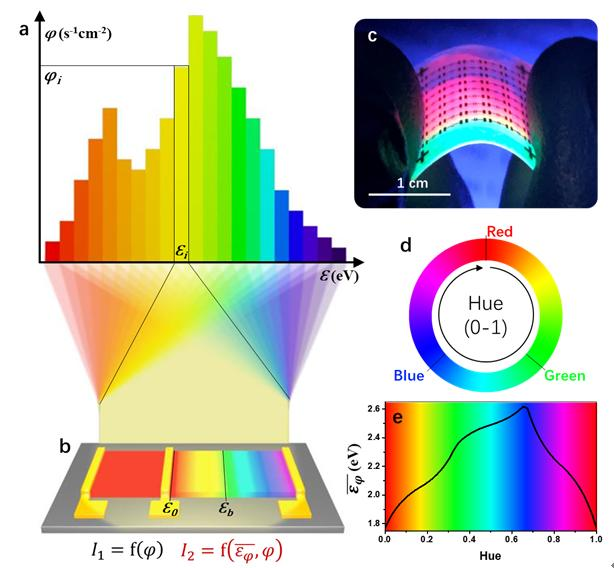Nov 12 2020
The human brain has the ability to process a huge number of spectral/light signals at high speeds, partially because it perceives lights as a mix of colors and intensities. But present-day photodetectors can only denote light intensities.
 (a) Spectral diagram. (b) Color perception using an optoelectronic device with bandgap-gradient semiconductors, in which one output signal is determined only by the total photon flux, and the other is dependent on both the total photon flux and average photon energy. (c) An image of the flexible devices under UV illumination. (d) Scheme of human visual color perception in terms of hue. (e) Correlation between hue and average photon energy. Image Credit: Mei-Na Zhang, Xiaohan Wu, Antoine Riaud, Xiao-Lin Wang, Fengxian Xie, Wen-Jun Liu, Yongfeng Mei, David Wei Zhang, and Shi-Jin Ding.
(a) Spectral diagram. (b) Color perception using an optoelectronic device with bandgap-gradient semiconductors, in which one output signal is determined only by the total photon flux, and the other is dependent on both the total photon flux and average photon energy. (c) An image of the flexible devices under UV illumination. (d) Scheme of human visual color perception in terms of hue. (e) Correlation between hue and average photon energy. Image Credit: Mei-Na Zhang, Xiaohan Wu, Antoine Riaud, Xiao-Lin Wang, Fengxian Xie, Wen-Jun Liu, Yongfeng Mei, David Wei Zhang, and Shi-Jin Ding.
Recently, scientists proposed that spectral curves of incident lights can be reconstructed by integrating dozens of photodetectors with semiconductors that exhibit different bandgaps. However, such techniques need chip-level device assembly and signal-processing system and can produce redundant signals for applications that do not require comprehensive spectral information.
As part of a new study led by Professor Shi-Jin Ding from State Key Laboratory of ASIC and System, School of Microelectronics, Fudan University, China, a research team has created an inexpensive, flexible optoelectronic cell with the ability to detect light intensity and perceive color. The device is inspired by human visual and psychological light perceptions and has been described in a paper published in Light: Science & Application.
The photoactive layer of the cell is developed using bandgap-gradient perovskites, which are made by a halide-exchanging technique by dipping in a solution. Photon absorption occurs only at energies beyond the bandgap of semiconductors; therefore, the devices can detect the spectral content of light signals at high resolution.
The new device generates two output signals: one responds linearly to both the flux and energy of photons, and the other is solely based on the flux of photon. The single device thus combines both the signals and projects the broadband and monochromatic spectra into the total photon fluxes and average photon energies (i.e., intensities and hues), which agree well with those realized using a commercial photodetector and spectrometer.
The new device can instantly generate intensity and hue results in real-time under varying illumination.
The researchers demonstrated the application of the color-perception device for chemical/bio-sensing. In the colorimetric chemical/bio-assay setup, chemical/bio-analytes change the color of the sensing material, and the bandgap-gradient device converts the change in color to an electrical signal.
For this simple proof of principle, a pH testing paper that transforms from red to green for pH values from 1 to 9 has been used. Such differences in color cannot be detected when a single silicon photodiode output current is used. Spectral curves of the pH testing papers quantified using a spectrometer under the same illumination can differentiate the various colors by presenting different peak positions.
But this technique not just needs bulky equipment but also produces spectral information that is redundant for sensing applications. The response of the bandgap-gradient device can clearly differentiate between the different pH values. Thus, the color-perception device efficiently realizes colorimetric chemical/bio-sensing with just a single device and by producing only one or two current signals.
The researchers stated, “We think that bandgap-gradient structures with high degrees of control can be achieved by other fabrication technologies with processing parameters that can produce a gradient. Colour-perception devices with excellent performance, small size and integratable structure would be achieved by further optimizing the selection of the optoelectronic material and the design of the bandgap-gradient structure.”
This device can be used in colour-sensing pixels, which may be more simplified than existing devices containing several photodetectors and optical filters. Multifunctional sensors can be produced by combining devices with stimuli-responsive materials to detect physical/chemical/bio-stimuli through a comparison of colours/spectra.
Study Researchers
“Therefore, this work provides a new category of optoelectronic devices that are capable of spectrum projection and hue perception, thereby opening up a range of colourful applications,” the researchers concluded.
Journal Reference:
Zhang, M.-N., et al. (2020) Spectrum projection with a bandgap-gradient perovskite cell for colour perception. Light: Science & Applications. doi.org/10.1038/s41377-020-00400-w.